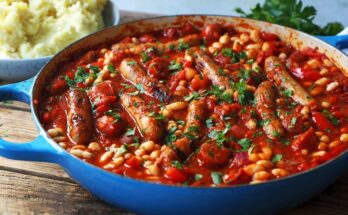Pork Roast Recipe: Pork roast is a timeless classic, often the centerpiece of festive gatherings or comforting family dinners. With its juicy interior and flavorful crust, this dish is beloved by many. Whether you’re hosting a holiday feast or looking to elevate a weeknight meal, mastering a pork roast will make you the hero of any kitchen.
So why is pork roast such a favorite? Beyond its hearty taste, it’s a versatile dish that can be seasoned, marinated, and cooked in countless ways.
Let’s dive into this step-by-step guide to help you prepare a pork roast that will impress your guests.
Ingredients Needed for a Perfect Pork Roast
Primary Ingredients
- 3-4 pounds of pork shoulder or loin
- Olive oil (3 tablespoons)
- Garlic cloves (4, minced)
- Fresh rosemary (2 sprigs)
- Fresh thyme (2 sprigs)
Seasonings and Herbs for Flavor
- Salt (1 tablespoon)
- Black pepper (1 tablespoon)
- Paprika (1 teaspoon)
- Optional: A pinch of cayenne for heat or brown sugar for sweetness
The right blend of spices and fresh herbs is key to creating a flavorful roast.
Preparing for the Pork Roast
Choosing the Right Cut of Pork
The cut of pork can make or break your dish. Popular options include pork shoulder for its marbled fat or pork loin for a leaner result. Choose a cut that matches your taste preferences and cooking style.
Prepping the Meat for Optimal Flavor
Start by patting the pork dry with a paper towel to remove excess moisture. This helps the seasoning stick better and promotes a crisp crust during cooking. Rub the meat generously with your seasoning blend, ensuring every inch is covered.
Essential Kitchen Tools You’ll Need
- Roasting pan
- Meat thermometer
- Kitchen twine (if trussing the meat)
- Aluminum foil
Step-by-Step Instructions for Cooking Pork Roast
Step 1 – Marinating the Pork
Combine olive oil, garlic, rosemary, thyme, and your seasonings in a bowl. Rub this mixture thoroughly over the pork, ensuring it seeps into every crevice. For best results, let the pork marinate for at least 2 hours or overnight in the refrigerator.
Step 2 – Preheating the Oven
Preheat your oven to 375°F (190°C). A well-heated oven ensures even cooking and a beautifully roasted crust.
Step 3 – Searing the Pork for a Crispy Crust
Before roasting, heat a skillet over high heat with a drizzle of olive oil. Sear the pork for about 3-4 minutes on each side until golden brown. This step locks in the juices and adds a delectable texture.
Step 4 – Roasting the Pork in the Oven
Place the seared pork in a roasting pan. Cook in the oven for 20 minutes per pound, or until the internal temperature reaches 145°F (63°C) for medium doneness. Use a meat thermometer to check accurately.
Step 5 – Resting the Roast Before Slicing
Once cooked, remove the pork from the oven and cover it loosely with aluminum foil. Let it rest for 10-15 minutes to allow the juices to redistribute, ensuring every bite is succulent.
Tips for Perfecting Your Pork Roast
Temperature Tips for Juicy Meat
Maintaining the right temperature is crucial. Avoid overcooking by checking the internal temperature frequently.
Common Mistakes to Avoid
- Not letting the meat rest after cooking
- Using the wrong cut for the recipe
- Skipping the searing step
Pairing Suggestions for a Complete Meal
Serve your pork roast with roasted vegetables, mashed potatoes, or a tangy apple chutney to complement its rich flavors.
Variations and Twists to Try
Herb-Crusted Pork Roast
Take your pork roast to the next level by adding an herb crust. Combine fresh parsley, thyme, rosemary, and a hint of lemon zest with breadcrumbs. Pat this mixture onto the marinated pork before roasting for a crispy, flavorful crust. This variation pairs wonderfully with a side of roasted root vegetables.
Sweet and Savory Glazed Pork Roast
For a sweet and savory twist, prepare a glaze using honey, Dijon mustard, soy sauce, and a splash of orange juice. Brush the glaze over the pork during the last 15 minutes of roasting. The result? A caramelized, sticky outer layer that’s impossible to resist.
Slow Cooker Pork Roast Option
Prefer a hands-off approach? Use a slow cooker. Season the pork as usual, place it in the cooker with onions, garlic, and a splash of chicken broth. Cook on low for 6-8 hours. This method produces a fork-tender pork roast that melts in your mouth.
How to Store and Reheat Pork Roast
Proper Storage Techniques
To store leftover pork roast, let it cool completely before placing it in an airtight container. Refrigerate for up to 3-4 days. For longer storage, wrap the pork tightly in plastic wrap and aluminum foil, then freeze for up to 3 months.
Reheating Without Losing Flavor
Reheat leftover pork in the oven at 325°F (160°C) to avoid drying it out. Cover it with foil and add a splash of broth or water to keep the meat moist. Microwave reheating is quicker but might compromise texture—use a low power setting for better results.
Nutritional Value of Pork Roast
Macronutrients Breakdown
A standard serving of pork roast (3 ounces) contains:
- Calories: Approximately 200-250, depending on the cut
- Protein: 22-25 grams, making it an excellent source of lean protein
- Fat: 10-12 grams, with variations based on the cut
Health Benefits of Lean Pork Cuts
Pork is rich in essential nutrients like vitamin B12, zinc, and selenium. Opting for lean cuts like loin or tenderloin keeps the dish healthy without sacrificing flavor. Its high protein content supports muscle repair and overall health, making pork roast a balanced choice for many diets.
FAQs About Pork Roast Recipe
What is the best cut of meat for pork roast?
The best cuts for a pork roast are pork loin, pork shoulder, or pork belly, depending on your desired texture and flavor. Pork loin is lean and tender, while pork shoulder is fattier and ideal for slow cooking.
How do I keep pork roast juicy?
To keep your pork roast juicy, avoid overcooking. Use a meat thermometer and cook until the internal temperature reaches 145°F (63°C). Let the roast rest for 10–15 minutes before slicing to retain its juices.
What seasonings work well with pork roast?
Popular seasonings include garlic, rosemary, thyme, paprika, and a mix of salt and pepper. A marinade or rub with olive oil, soy sauce, or mustard can also enhance flavor.
Can I cook pork roast in a slow cooker?
Yes! Pork roast cooks beautifully in a slow cooker. Add your favorite seasonings, vegetables, and broth, then cook on low for 6–8 hours or high for 4–5 hours until tender.
How do I know when pork roast is done?
Use a meat thermometer to ensure the internal temperature is 145°F (63°C). The meat should be slightly pink in the center and easy to slice.
What side dishes go well with pork roast?
Classic side dishes include roasted vegetables, mashed potatoes, apple sauce, or a fresh green salad. For a more festive touch, pair it with cranberry sauce or glazed carrots.
Conclusion
Making pork roast at home doesn’t have to be intimidating. With the right preparation, attention to detail, and a bit of creativity, you can create a dish that rivals any restaurant offering. Whether you stick to a classic recipe or experiment with unique twists, a well-cooked pork roast is sure to delight your taste buds and those of your guests.
So roll up your sleeves, preheat that oven, and start your pork roast journey today. Once you’ve nailed it, you’ll wonder why you didn’t try it sooner. Happy roasting!



